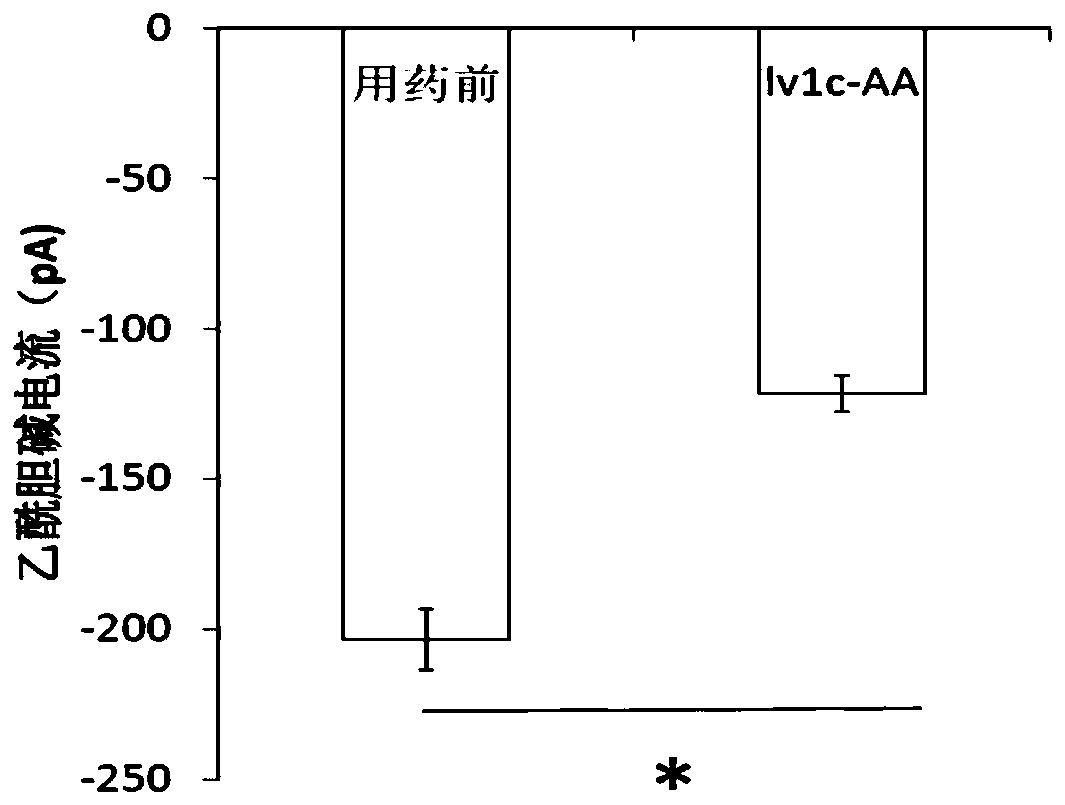Conotoxin mutant polypeptide lv1c-aa and its application and preparation method
A technology of lv1c-aa and conotoxin, which is applied to molecular probes and analgesic drugs, polypeptide compounds, conotoxin mutant lv1c-AA and the field of preparation thereof, which can solve the problem that conotoxin resources are not yet available. research and development issues
- Summary
- Abstract
- Description
- Claims
- Application Information
AI Technical Summary
Problems solved by technology
Method used
Image
Examples
Embodiment 1
[0026] Example 1: Solid-phase synthesis and separation and purification of the conotoxin lv1c mutant lv1c-AA, that is, the preparation method of the conotoxin mutant polypeptide lv1c-AA, which is prepared in the following manner:
[0027] Step 1: Put a certain weight of Wang resin into the synthesis column, wash it with dimethylformamide (N, N-dimethylformamide, DMF) for 3 times, then add 3-4ml of DMF, and feed nitrogen to make Wang resin in the solution Soak and turn up and down for 20-40 minutes, blow dry with nitrogen. Here, the Rink resin Rink can be set between 0.1g and 0.3g. Here, 0.2g is used to load the synthesis column, and the Rink resin is the RinkAmide resin (RinkAmide).
[0028] Step 2: Add 2-3ml of 20% piperidine to remove the protection of 9-fluorenylmethoxycarbonyl (Fmoc), and react with nitrogen gas for 10-20 minutes; then rinse with DMF for 3 times; repeat the deprotection once, and react with nitrogen gas for 10 minutes -20 minutes, rinse with DMF 4 times, ...
Embodiment 2
[0039] Example 2: Conotoxin mutant lv1c-AA has better analgesic activity than conotoxin lv1c and MVIIA.
[0040] MVIIA is a clinical analgesic drug, and its Chinese name is Qikao polypeptide; lv1c: is the name of the polypeptide before the mutation.
[0041] The analgesic activity of lv1c-AA was determined by the acetic acid writhing method. Kunming mice weighed about 18 g, half male and half male, and randomly divided into groups of 8 mice. The intracerebroventricular injection concentration was 5 μg / μl, and each mouse was injected with 10 μl. At intervals of 1.5h, 3h, and 6h, 0.7% acetic acid was injected intraperitoneally, 20 μl per mouse. The number of writhing times of the mice within 15 min was recorded, and the average value was taken for each group. And compare the significance of writhing frequency difference with normal saline control group. The result is as figure 2 shown. Experiments showed that the analgesic activity of lv1c and its mutant lv1c-AA was super...
Embodiment 3
[0042] Example 3: Inhibitory effect of lv1c-AA on acetylcholine current in hippocampal neurons
[0043] Newborn wistar rats within 24 hours of birth were decapitated, their brains were removed, meninges were separated, and hippocampus were removed, and hippocampal neurons were isolated and cultured by conventional enzymatic hydrolysis for power supply physiological research.
[0044] The hippocampal neurons cultured for 8-9 days were rinsed twice with extracellular solution, and 2ml of extracellular solution was added for experiment. The recording electrode is pulled by the two-step method of the electrode puller, and then thermally polished by the electrode polisher before use, so that the diameter of the tip of the microelectrode is about 1 μm, and the impedance after filling the electrode liquid is 4-5MΩ. The caliber of the administration electrode used to record the current of the acetylcholine receptor is about 3-4M, and the inside is filled with 1mM ACh (prepared from ex...
PUM
| Property | Measurement | Unit |
|---|---|---|
| impedance | aaaaa | aaaaa |
| control rate | aaaaa | aaaaa |
Abstract
Description
Claims
Application Information
 Login to View More
Login to View More - R&D
- Intellectual Property
- Life Sciences
- Materials
- Tech Scout
- Unparalleled Data Quality
- Higher Quality Content
- 60% Fewer Hallucinations
Browse by: Latest US Patents, China's latest patents, Technical Efficacy Thesaurus, Application Domain, Technology Topic, Popular Technical Reports.
© 2025 PatSnap. All rights reserved.Legal|Privacy policy|Modern Slavery Act Transparency Statement|Sitemap|About US| Contact US: help@patsnap.com



